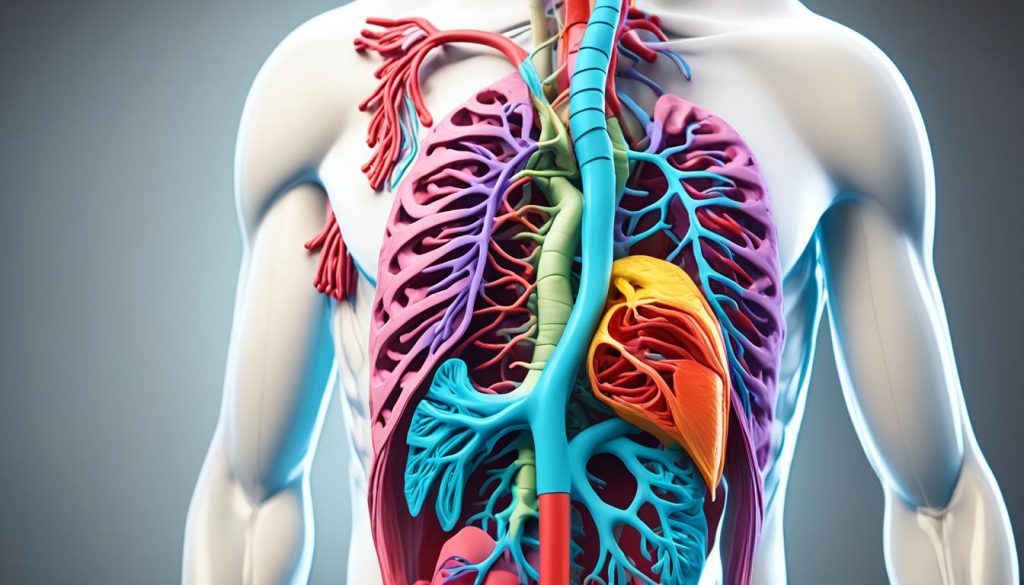Abdominal aortic aneurysm is a chronic disease where the abdominal aorta gets swollen and bigger. This issue usually has no symptoms at start. But, it can be very dangerous if it bursts.
The disease is caused by many factors like genes, smoking, high blood pressure, and family history. It’s key to know the reasons, signs, and how to find it early. This knowledge helps in stopping severe problems and treating it well.
To find an aneurysm, doctors use imaging like ultrasound or CT scans. These tests show the size of the aneurysm and check for problems. Catching it early is vital for good health outcomes.
Stem cell therapy is a new way to possibly treat aortic aneurysms. It uses stem cells to heal the aorta’s damaged parts. Even though it’s still being tested, the results look hopeful for the future.
Key Takeaways:
- Abdominal aortic aneurysms cause the belly’s main artery to grow.
- It often starts without any signs but can be life-threatening if it tears.
- Causes include genes and living habits like smoking and high blood pressure.
- Imaging tests like ultrasound help with diagnosis.
- Stem cell treatment offers hope for the future of aneurysm care.
Understanding the Pathogenesis of Aortic Aneurysms
Aortic aneurysms develop due to many factors working together. These include a buildup in the arteries, swelling because of inflammation, and stress on the artery walls.
The walls of the aorta weaken and stretch in aortic aneurysms. This is often due to the breakdown of the wall’s support, muscle changes, inflammation, and new blood vessels forming.
Plaque buildup in arteries, known as atherosclerosis, is a big part of aortic aneurysm development. It can cause the release of certain enzymes that eat away at the aorta’s strength.
Having certain genes can make an aortic aneurysm more likely. If genes affecting the aorta’s structure are flawed, it can lead to a weaker wall and a higher risk of an aneurysm.
Blood flow also plays a role. When blood’s force on the artery walls is not normal, it can scare the wall and start an aneurysm. This is called hemodynamic shear stress.
Knowing how aortic aneurysms start is key to finding good treatments. Targeting these causes can help doctors and scientists prevent or slow down the damage aortic aneurysms cause.
Genetic Factors and Thoracic Aortic Disease
Genetics are key in thoracic aortic disease. Changes in genes that make collagen and elastin can cause aortic aneurysms. Knowing the genetic roots helps spot those at risk and create spot-on treatments.
Marfan syndrome and Loeys-Dietz syndrome raise the chances of aortic aneurysms. These conditions mess with the body’s connective tissue, making the aorta’s wall weaker. This puts people at higher risk for aneurysms.
To visualize the genetic factors involved in thoracic aortic disease, refer to the table below:
| Genetic Factors | Associated Risks |
|---|---|
| Mutations in genes involved in collagen production | Increase the risk of weakened aortic walls |
| Gene mutations seen in Marfan syndrome | Higher susceptibility to thoracic aortic aneurysms |
| Gene mutations seen in Loeys-Dietz syndrome | Elevate the risk of thoracic aortic aneurysms |
The genetic part of thoracic aortic disease is both complicated and has many pieces. Researchers study these genes to understand how the disease grows. This helps find new treatments. Genetic tests and advice can show people their aneurysm risks. This info guides them in taking good care of their health.
Risk Factors and Screening for Abdominal Aortic Aneurysms
Abdominal aortic aneurysms have several risk factors linked to their growth. These include getting older, smoking, high blood pressure, and if your family has a history of this disease. Getting older significantly increases your chances of having an abdominal aortic aneurysm. Smoking is a big, changeable risk, making you much more likely to get one. High blood pressure weakens your aortic wall and can lead to an aneurysm. If your family has a history of these aneurysms, your risk goes up.
To lower the risks of an abdominal aortic aneurysm, getting screened is a good idea, especially if you’re 65 or older and a past smoker. Screening uses imaging tests. The most common one is ultrasound, which is easy and doesn’t hurt. It checks for the aneurysm’s size and where it is. Finding an aneurysm early can lead to better outcomes, as it allows doctors to step in on time, lowering serious risks or death.
| Age | Smoking | Hypertension | Family History |
|---|---|---|---|
| Influences the incidence of abdominal aortic aneurysms | Major modifiable risk factor | Weakens the aortic wall | Higher risk for individuals with a positive family history |
| Increases with advancing age | Significantly increases the risk | Contributes to aneurysm formation |
Diagnosis and Imaging of Abdominal Aortic Aneurysms
Diagnosing an abdominal aortic aneurysm includes using different imaging tests. The main test used is ultrasound.

Ultrasound is safe, and it doesn’t hurt. It uses sound waves to show images of the stomach’s main artery. This helps doctors see the bulge and check its size.
Computed tomography (CT) scans and magnetic resonance imaging (MRI) give a more detailed look. They show where the bulge is, how big it is, and how severe the issue is.
A CT scan takes special X-ray images of the belly area. It offers clear pictures that doctors use to check the vessel’s wall closely.
MRI uses magnets and radio waves to create stomach artery pictures. It shows more on soft areas, spotting any break or other problems clearly.
Clear diagnosis through imaging is key in treating stomach artery bulges. These tests help in seeing how bad things are, deciding on a treatment, and watching bulges grow over time.
Treatment Options for Abdominal Aortic Aneurysms
The way doctors treat abdominal aortic aneurysms depends on their size and how likely they are to burst. For small ones, just keeping an eye on them might be enough. But if they’re big or at risk of bursting, surgery or EVAR might be the way to go.
Doctors usually consider two main surgeries for aortic aneurysms:
- Open Repair: Doctors make a cut in the belly to get to the aneurysm. They replace the weak part of the aorta with a man-made tube. This method is often seen as the best, especially for hard cases. But, it’s a big operation that takes time to heal from.
- Endovascular Repair: This is a simpler surgery that uses a tube to fix the aorta. Doctors insert a tube through a small cut in the leg and guide it to the aneurysm. This tube keeps the blood from putting too much pressure on the aneurysm, which can stop it from growing and bursting. Compared to open repair, this way is easier on the body and has a quicker recovery time. But, it doesn’t work for all aneurysms, especially the odd-shaped or the ones in tricky spots.
The best pick for treatment depends on each patient’s situation and the doctors’ skills. They look at age, health, and the aneurysm’s shape to choose the best way to fix it.
If someone has an abdominal aortic aneurysm, talking to a vascular surgeon is crucial. They will weigh the choices and help decide the best treatment for that specific aneurysm.
| Treatment Options | Advantages | Disadvantages |
|---|---|---|
| Small Aneurysm Monitoring | – Non-invasive – Avoids surgical complications |
– Requires regular monitoring – Risk of aneurysm growth or rupture |
| Open Repair | – Gold standard treatment – Suitable for complex cases |
– Major surgery – Longer recovery time |
| Endovascular Repair | – Minimally invasive – Faster recovery time |
– May not be suitable for all cases – Risk of complications such as endoleaks |
Complications and Prognosis of Aortic Aneurysms
Abdominal aortic aneurysms can cause big problems like aortic rupture or dissection. Aortic rupture is very dangerous and needs quick medical help. The size and location of the aneurysm, plus other health issues, affect the outcome. Finding and treating an aneurysm early can really help.
Complications of Aortic Aneurysms
Having an aortic aneurysm comes with serious risks. Aortic rupture is the worst, causing a tear and heavy bleeding. It leads to sudden, strong pain and needs surgery right away. Without treatment, it can be deadly.
Aortic dissection is another problem. It’s when the aortic wall’s inner layer tears. Blood flows between layers, sometimes harming organs. It causes strong chest or back pain. Quick medical care is crucial to avoid more issues.
Thrombosis, or blood clotting in the aneurysm, is also dangerous. Clots can block blood flow or travel to other areas, causing strokes. It’s risky and needs prompt attention.
Prognosis of Aortic Aneurysms
Aortic aneurysms’ outlook depends on many things, including size and location. Smaller ones are less risky than larger ones. The type of aneurysm also matters.
Health issues like high blood pressure or heart disease affect the prognosis too. More health problems mean a harder time recovering. Age plays a big role too, often affecting the outcome.
Early diagnosis and care are key for a better prognosis. Regular check-ups can spot aneurysms before they’re a problem. Doctors can then choose the best treatment to avoid complications and improve health.
People with aortic aneurysms should stick to their doctor’s plan. This means regular check-ups, healthy living, and taking prescribed medicine. It can greatly reduce the risk of problems and help with recovery.
Breakthrough Stem Cell Therapy for Aortic Aneurysms
Stem cell therapy offers hope for aortic aneurysm patients. It uses stem cells to repair and grow new aortic tissue. This gives new hope to those hit by this serious issue.
Research looks into mesenchymal stem cells (MSCs) and other types. They can turn into different cell types and help fix tissues. So far, these studies have shown good results.
This therapy places these special cells where they’re needed. They boost natural healing by helping new tissue grow. This way, the therapy targets the aneurysm’s cause and helps regenerate the tissue.
Yet, we need more research to be sure about this therapy’s safety and effectiveness. Studies continue to look into the best ways to use stem cells. They look at dosages and what happens over time after treatment.
Potential Benefits of Stem Cell Therapy for Aortic Aneurysms:
- Promotes tissue repair and regeneration
- Addresses the root cause of the aneurysm
- Potentially reduces the risk of complications
- Offers an alternative to invasive surgical procedures
Regenerative medicine is moving forward. Stem cell therapy for aortic aneurysms is at the heart of this. It promises to better the lives of those with this heart issue.
Conclusion
If you have an abdominal aortic aneurysm, taking good care is key. Quitting smoking is a big first step because it greatly raises your risk. It’s also important to keep your blood pressure in check, which means you should check with your doctor regularly and take your meds.
Getting enough exercise is also crucial. Moderately walking fast or swimming can make your heart and body stronger. But don’t forget to talk to your doctor before you start any new workout plan.
Keeping up with your doctor visits and tests is a must. These checks keep tabs on your aneurysm, helping doctors decide on the best next steps. And there’s always new treatments like stem cell therapy that might improve your situation. It’s smart to know about these too.
As we learn more, we improve how we treat abdominal aortic aneurysms. With the right care, lifestyle, and up-to-date treatments, living with this issue can be manageable. It allows you to live fully, keeping the risks low.

